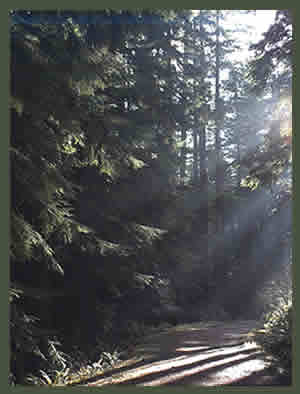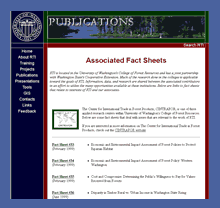|
The following fact sheets are published as summaries highlighting
research results. We've made them available to provide an easy
source
of information regarding the activities of RTI, as well as other
research projects being performed by RTI associates that expand
upon forestry related issues. You can save or print any fact sheet
by clicking the PDF link. You can also order a free copy by
contacting
Clara Burnett at (clara75 u.washington.edu)
or call her at (206) 616-3218. u.washington.edu)
or call her at (206) 616-3218.
Fact Sheet #44: Eastern Washington Biomass Accessibility. Forest residuals represent the largest unexploited source of biomass feedstock for energy in Washington. Understanding the accessibility of biomass feedstock becomes a critical criterion in making the new investments which will be required to reach both state and federal energy goals. (Save or print a PDF copy)
Fact Sheet #43: Wood to Energy in Washington: Imperatives, Opportunities, and Obstacles to Progress - Summary Brief of Findings and Recommendations. At the request of the Washington State Legislature, a thorough investigation into the barriers to increasing utilization of woody biomass for energy production in Washington has been conducted by University of Washington scientists. Identifying barriers and recommending solutions required an assessment of how the broader energy policies of the state and nation impact biomass energy opportunities. (Save or print a PDF copy)
Fact Sheet #42: Eastern Washington Biomass Accessibility Study – Chattawood Case Study. In 2007 the Washington State Legislature directed the University of Washington College of Forest Resources to undertake a study of forest biomass availability as prior studies had identified forest residuals as the largest unexploited source of biomass feedstock for energy in Washington. (Save or print a PDF copy)
Fact Sheet #41: The Economic Cost for Silvicultural Management to Restore or Enhance Habitat. Thinning treatments, i.e. Biodiversity Pathways to attain old forest conditions, have been shown to be much better than just long rotations as they reduce both the time necessary for the stand to take on old forest attributes and provide revenue to the landowner along the way. (Save or print a PDF copy) |
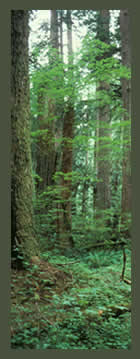 |
Fact Sheet #40: Update on Eastern Washington Mortality Trends with Implications for Eastern Washington Timber Supply. Because of the magnitude of changes that eastern Washington pine forests are
experiencing, specific analysis of forest health trends for lodgepole and ponderosa pines were
targeted for detailed study. This paper summarizes the nature of the problem and its implications for long term timber supply. (Save or print a PDF copy)
Fact Sheet
#39: Combine Digital Media
Technologies to Produce an Interactive Distance Learning
Tool. The Rural Technology Initiative (RTI) implemented
a web browser-based distance learning tool to convey
information across the internet, closed networks, and
on local computers using a free Microsoft® PowerPoint® add-in
(Microsoft Producer®) to combine video, audio, slides,
images, HTML links, and an interactive table of contents. (Save or print a PDF copy)
Fact Sheet
#38: Management Templates for Increased
Biodiversity and Economics in Intensively Managed Loblolly
Pine Plantations. To promote increased biodiversity
on private ownerships, management strategies should be identified
that balance biodiversity and economic goals. Using an RTI
template for Washington as the framework, an example
template has been created for increasing biodiversity in
southern loblolly pine plantations. (Save or print a PDF copy) |
|
Fact Sheet #37: Increasing Biodiversity in Intensively Managed Loblolly Pine Plantations: A Literature Review. Most of the forestland in the South is in private ownership, and much of it is comprised of intensively managed plantations of fast-growing loblolly pine. This fact sheet summarizes a review of the literature that identifies a spectrum of practices for supporting increased biodiversity in intensively managed loblolly pine plantations. (Save or print a PDF copy)
Fact Sheet #36: Technology
Transfer from Research to Forestry Applications: Using
the Landscape Management System (LMS). LMS enables
users to understand the complex impacts of treatments and
disturbances and the tradeoffs between different outcomes
in order to select strategies that produce the most desirable
future conditions. This Fact Sheet summarizes who has been
using LMS and their applications. (Save or print a PDF copy)
Fact Sheet #35: The
Economics of Forest Health in Eastern Washington.
Numerous studies and annual monitoring indicate that outbreaks
of insects and disease coupled with increasing fire risk
in unburned areas will continue and become increasingly
severe. Analysis of potential treatment regimes for two
common stand types was undertaken to determine likely forest
health outcomes with and without incentives and education
regarding forest health issues. (Save or print a PDF copy)
Fact Sheet #34: A
comparison of riparian regulation effectiveness in Western
Washington and Oregon. Ten case studies of small
forest ownerships located west of the Cascade Mountains
were used to examine the comparative costs and effectiveness
of the WA and OR regulations Alternative riparian management
plans are allowed under the regulations in both states
and were included as part of this study to examine management
options for better achieving riparian habitat objectives
at a lower cost to landowners. (Save or print a PDF copy) |
 |
Fact Sheet
#33: The LMS Fire Scoping Tool: Stand- and Landscape-level
Fire Assessments using LMS. The Landscape Management
System (LMS) with the Fire Scoping Tool and the Fire
and Fuels Extension for the Forest Vegetation Simulator
growth model (FFE-FVS) provides an easy-to-use platform
for stand- and landscape-level simulations of stand growth
with and without silvicultural treatments, fire effects
and behavior estimation, assessment (scoping) of fire
potentials, and analysis in support of fuel treatment
planning. (Save or print a PDF copy)
Fact Sheet #32: Agency
Retirements and Enrollment Declines Create Shortage of
Natural Resource Professionals. Reports
from the Renewable Natural Resources Foundation and the
National Association of Professional Forestry Schools and
Colleges warn of a growing shortage of qualified natural
resource professionals needed to fill positions vacated
by retiring baby boomers. (Save or print a PDF copy)
Fact Sheet #31: Measures for Forest Health in Eastern
Washington Habitat Types. By using a measurement of stand
vigor called growth basal area (GBA), the inherent site carrying capacity in
eastern Washington can be better measured than by using density, relative density,
and basal area. (Save or print a PDF copy)
RTI Progress and
Impact Statement: A Collaborative University of Washington/Washington
State University Technology Transfer Center Serving Rural
Timber Communities. RTI has compiled
a short activity report that summarizes what we have
done while also trying to convey more directly what impacts
we have had. (Save or print a PDF copy)
Fact Sheet #30: LMS Economatic: The “Economatic” is
a spreadsheet-based economic and financial analysis companion
program for the Landscape Management System (LMS). LMS is
a free software package that integrates forest growth, visualization,
and spatial models in a user-friendly environment. (Save
or print a PDF copy) |
| Fact Sheet #29: LMS Inventory
Wizard: The Inventory Wizard is a tool that makes it
easy to get started with the Landscape Management System
(LMS). It guides users through the process of assembling
the forest inventory data needed to run LMS. (Save or print
a PDF copy) |
| Fact Sheet #28:
Investments in Fuel Removals Avoid Future Public Costs: A
recently completed cost/benefit analysis conducted by the
Rural Technology Initiative (RTI)
as part of a broad investigation of fire risk reduction indicates
that the negative impacts of crown fires are underestimated
and that the benefits of government investments in fuel reductions
are substantial. (Save or print a PDF copy) |
| Fact
Sheet #27: Wildlife Habitat Modeling and Assessment using
LMS: Using the Landscape Management System, which links
habitat models with current and future forest inventories,
projected with forest growth and yield models, to give current
and potential future habitat conditions created by forest
growth and management. (Save or print a PDF
copy)
Fact Sheet #26: Washington
State's Forest Regulations: Family Forest-owners' understanding
and opinions: This paper explores the current knowledge
of WA family-forest owners regarding the following state environmental
regulations: the Forest Practices Rules, the Forests and Fish
Law, and the Road Management and Abandonment Plan; and how
those regulations are expected to impact the economic viability
and long-term objectives of forest owners in Washington State.
(Save or print a PDF
copy)
Fact Sheet #25: Alternate
Planning for small forest landowners in eastern Washington
under the Forest and Fish Rules: An alternate plan approach
was developed using stand density index (SDI) to integrate
the economic, riparian function, and biological criteria necessary
to reduce riparian stand susceptibility to infestation by
Mountain Pine Beetle (Dendroctonus ponderosae, Hopkins). (Save
or print a PDF
copy)
Fact Sheet #24: The Emerging
Consensus for Active Management in Young Forests: Scientific
evidence has shown that thinning of younger forests can accelerate
the development of old growth characteristics. (Save or print
a PDF copy) |
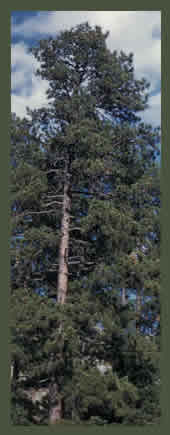 |
|
Fact Sheet #23: An integrated
process for developing alternate plan templates for overstocked
stands: It addresses the issue of creating templates to
facilitate the development of alternate riparian management
plans for family forest owners in Washington State. (Save
or print a PDF
copy)
Fact Sheet #22: After decades
of Douglas-fir plantations, is it time for forest landowners
to consider planting alder and cedar?: This fact sheet offers
some reasons to consider a transition in the Pacific Northwest
from replanting with Douglas-fir to alder and cedar. (Save or
print a PDF copy)
Fact Sheet #21: Forest Landholders
and Fire: A Case Study in Two Counties in Northeastern Washington
State: This study focuses on the role of fire both as
a perceived threat and a management tool of NIPF and Tribal
forestland owners/managers in two counties in northeastern
Washington state. (Save or print a PDF
copy) |
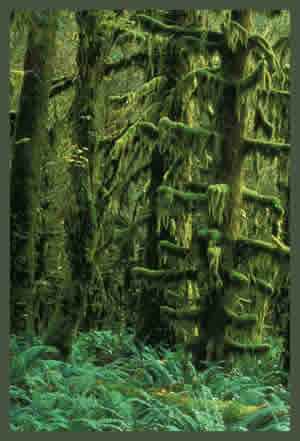 |
Fact Sheet#20: Impacts
of the Forest and Fish Rules on Non-Industrial Private
Forest landowners in north eastern Washington: Some key
consequences from riparian zone case study evaluation: shows
economic effects of Forest and Fish Rules in Eastern Washington.
(Save or print a PDF copy)
Fact Sheet#19: A Systems
Approach to Sediment Reduction from Forest Roads with Cross
Drains - CulSed: a new decision support tool for cross
drain culvert design developed by research assistants and
staff at the RTI. (Save or print a PDF copy)
Fact Sheet #18: The Use
of Forestry Education Programs by Small-scale Family Forest
Landowners in Washington State: Does Ownership Size Make
a Difference in Their Educational Needs? (Save or print
a PDF copy) |
|
Fact Sheet #17: The Role
of Forests and Forest Management on Carbon Storage: The
Consortium for Research on Renewable Industrial Materials
(CORRIM) confronts the question of the forests role in storing
carbon and the impact of forest management on carbon storage.
(Save or print a PDF
copy)
Fact Sheet #16: Ecosystem
Management and Non-industrial Private Forest Landowners in
Washington State: gives results of a mail survey taken
by Washington State NIPF landowners. (Save or print a PDF
copy) |
| Fact Sheet #15: Advanced
Quality Control and Standardization Technology for Better
Special Forest Products Management: Looks at the steps
being taken in the development of special forest products
as a profitable non-industrial activity. (Save or print a
PDF copy)
Fact Sheet #14: An
Examination of the Potential for Riparian Buffers on Agricultural
Lands to Augment Farm Incomes, Increase Hardwood Inventories,
and Protect Streams: Examines different plans that are
being implemented and studied on agricultural lands. (Save
or print a PDF
copy)
Fact Sheet #12: Economic
impacts of RMAPs and required road upgrades on small forest
landowners in Eastern Washington: The nature of the economic
impacts from RMAPs and the associated road upgrade costs are
different for Eastside landowners compared to the Westside.
This fact sheet demonstrates the potential economic hardship
of road upgrade costs for individual small forest landowners
in Eastern Washington. (Save or print a PDF
copy) |
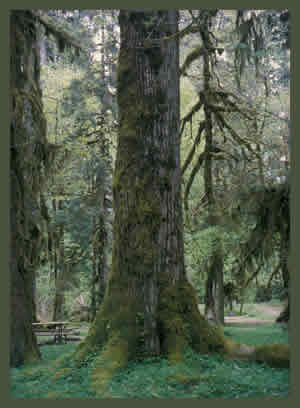 |
| Fact Sheet #11: Economic
impacts of RMAPs and required road upgrades on small forest
landowners in Western Washington: Forest landowners, regardless
of size, are required to prepare a Road Maintenance and Abandonment
Plan (RMAP) that outlines how their forest roads will be brought
into compliance with the new regulations. This hits on the
economics behind these new rules. (Save or print a PDF
copy)
Fact Sheet #10: Integration
Across Disciplines: Investing in Technologies to Produce
Products, Energy, and Restoration of Forest Health in
Fire Prone Forests
of the Inland West: This fact sheet gets into the economics
of thinning small diameter trees as protection against catastrophic
forest fires. (This Fact Sheet has been updated. The more
recent information can be found in Fact
Sheet #28).
Fact Sheet #09: The Impact
of Riparian Forest Management on Large Woody Debris (LWD)
Recruitment Potential: Large woody debris (LWD) recruitment
plays an integral role in the production and maintenance of
riparian and aquatic habitat. (Save or print a PDF
copy)
Fact Sheet #08: The Impact
of Riparian Forest Management on Shade Production: Discusses
the impact of forest management on shade production. (Save
or print a PDF
copy) |
|
Fact Sheet #07: Will Low
Prices for Large Logs Mean Shorter Rotations on Private Forestlands?
Investigates the effects of regulations since 1989 on log
prices and stand rotations. (Save or print a PDF
copy)
Fact Sheet #06: Defining
and Using Biologically Based Targets in Forest Management:
Incorporating Forest Structure and Variability: A technical
report using biologically based targets to better predict
regulatory effects. (Save or print a PDF
copy)
Fact Sheet #05: The Washington
State Small Forest Landowner Database: House Bill 2091
of the Washington State Legislature authorized the creation
of a database on non-industrial private forestland (NIPF)
that could provide reliable reports assessing ownership patterns
such as information on watershed coverage, forest management,
and housing. (Save or print a PDF
copy)
|
|
| Fact Sheet #04: NIPF
Road Upgrade and Stream Crossing Costs under Washington Forest
and Fish Regulations: Information on stream crossing and
road maintenance costs were collected for the Small Business
Economic Impact Statement (SBEIS). (Save or print a PDF
copy)
Fact Sheet #03: Case studies
examining the economic impacts of the Forests and Fish rules
on NIPF landowners in Eastern Washington: Examines the
economic impacts of new forest regulations in Stevens County
and Pend Oreille County. (This Fact
Sheet has been updated. The more recent information can be
found in Fact
Sheet #20).
Fact Sheet #02: Case studies
examining the economic impacts of the Forests and Fish rules
on NIPF landowners in Western Washington: Examines the
economic impacts of new forest regulations on 10 Western Washington
case studies. (Save or print a PDF
copy)
Fact Sheet #01: Impact of
the Forest Sector in the Washington State Economy:
Over 20,000 owners in WA State manage forestland for commercial,
recreational and resource protection objectives. (Save or
print a PDF copy) |

|
|
RTI Associated Fact
Sheets
For more Fact Sheets from other disciplines within the UW
College of Forest Resources, click
here. |
|












